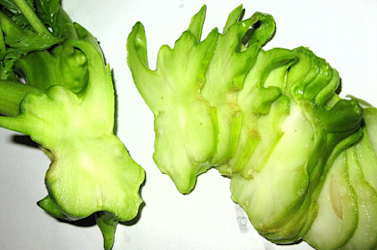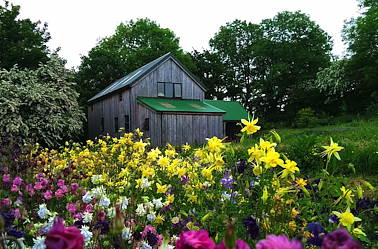MUSTARD GREENS for eating COOKED:
Very easily-grown greens for cooking (like chard, spinach etc) from the mustard family.
Raw they are spicy - so although it is nice to put small quantities raw in salads, they're mostly used cooked.
Apart from the great taste, an advantage of these is that
they are left alone by many pests
- they're only attractive to animals that
know how to cook!
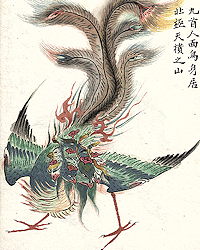
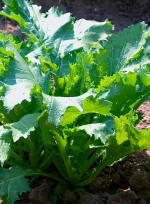 "Nine Headed Bird" Cunning Greens
"Nine Headed Bird" Cunning Greens
The name in Chinese is written ![]() , or 'Jiu Tou Niao', which means "Nine Headed Bird". It is an old heirloom variety of mustard leaf from South China, with green serrated leaves, & is prized locally for the texture and flavour of the greens.
, or 'Jiu Tou Niao', which means "Nine Headed Bird". It is an old heirloom variety of mustard leaf from South China, with green serrated leaves, & is prized locally for the texture and flavour of the greens.
We were recently sent more detail by Dr Grabowska-Zhang (see the feedback box below) This is a good mustard green and we hope you enjoy growing it.
Hot and spicy raw, tasty and mild cooked. There are many local varieties of this sort of green yet to be discovered in the West.
 200 seed, organic
£
200 seed, organic
£
Small screen: Turn your device sideways to view sowing calendar.






















































FEEDBACK:
I am particularly pleased with the range of oriental vegetables you offer. I have a cross-cultural family, and it is always good to find new things to grow that are expensive/hard to get... I have just sown your Chinese mustard greens (OVNi), and I want to point out that jiu tou niao means nine-headed bird, which is a mythical creature from the culture of ancient native people of the Hubei province... The symbolic meanings are sometimes lost in translation, but cunning is one of the adjectives often used to describe the beast. I am looking forward to seeing my cunning mustard grow :) - Dr Ada Grabowska-Zhang
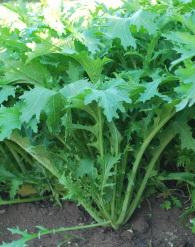
Feather
We found another closely related variety from the same part of China. 'Feather' is an early-maturing heirloom mustard green, with big green ruffled leaves and a green stem. It has a good flavor and excellent texture.
Hot and spicy raw, tasty and mild cooked.
![]() approx 200 seed
£
approx 200 seed
£
Small screen: Turn your device sideways to view sowing calendar.






















































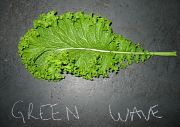
Green Wave
Big green leaves with frilly edges - Green Wave is great because it not only thrives in cool weather, but is also relatively tolerant of heat, so can be sown both in spring & after midsummer.
It is really, really impressively cold-hardy. Not only can you extend the season in a polytunnel, but also we find that plants left outdoors often overwinter perfectly well, making a good crop of leaves in spring.
All in all, a hardy and easily grown plant, making masses of cooking greens. When it finally does run to seed, the flower shoots are very nice cooked like sprouting broccoli, too!
Hot and spicy raw, tasty and mild cooked.
When? You can sow it most times of the year. Normally though, sow in spring (earliest under cover) & again after midsummer.
Small screen: Turn your device sideways to view sowing calendar.














































































Osaka
Purple
This is a deep purple mustard green, with amazingly huge oval leaves that are purple and green with white veins. They make a big rosette and eventually a heart as well.
We like this because it is cold-hardy - sow it after midsummer for use overwinter.
This nice seed from Frank & Karen Morton was specifically bred for home gardeners. It is a particularly vigorous variety, growing on well even in less than ideal weather, and very cold-hardy, standing on into winter.
Hot and spicy raw, tasty and mild cooked.
When? For sowing just after midsummer, and harvest overwinter. Osaka Purple should only be sown after mid-summer; it will bolt if sown in spring.
Small screen: Turn your device sideways to view sowing calendar.





















































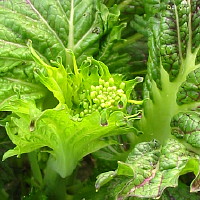
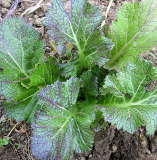 Dragons Tongue
Dragons Tongue
A great new mustard green. It has huge leaves with amazing wiggly white ribs and purple highlights.
It is mildish when young and small quantities can be added raw to salads. As it gets bigger it gets hotter raw, and then is really nice cooked, leaving just a slight spicy tingly richness in the flavour.
We grow this every year using it young in winter salads then as it matures cooking it in stirfries, curries and as a side-dish.
Sweet when young, very big and productive.
When? For sowing just after midsummer, and harvest overwinter. But we have found it does well in spring too, so give it a go then too.
Small screen: Turn your device sideways to view sowing calendar.













































































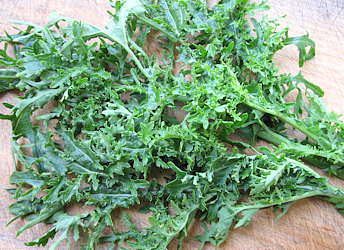 Golden Frills MILD
Golden Frills MILD
A whole new class of vegetable here – a unique salad leaf from a cross between a kale and mustard. The plants make large but delicately frilly leaves with a golden-green colour, and a sweet, but only slightly spicy flavour.
It goes well in salads as the lacey leaves add a delicate bit of ‘zing’. Can also be cooked as a green.
 approx 200 seed, organic £
approx 200 seed, organic £
When? Sow in early spring or after midsummer for best results
Small screen: Turn your device sideways to view sowing calendar.




















































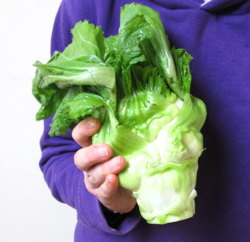 Wa Wa Ga Choi Stem Vegetable (a.k.a. "The Thing")
Wa Wa Ga Choi Stem Vegetable (a.k.a. "The Thing")
Definitely our strangest vegetable. A unique sort of plant from Szechuan in China, where it is famous. How on earth to describe it?
The stem swells up like a kohl-rabi but making lots of bumps rather than one big one. The flavour is savoury, and somewhat - but not very - spicy. Use the swollen stem & buds as an exceptionally delicious addition to stirfries, or enjoy them raw in salads or just to munch on as a snack or with dips. The leaves are mustard-spicy and best cooked - use them all the ways you'd use regular mustard green leaves. The tips of the bumpy bits of stem can get quite spicy-hot as the plant gets bigger, so peel them if this is the case.
Be aware that this is slightly tricky timing-wise: If sown in normal Spring sowings it will just bolt – instead, sow in September for overwintering, or sow VERY early right at the start of Spring under cover. It makes leaves quite quickly, say 4 or five weeks to a reasonable plant size; then it makes the swollen stem which should be ready roughly 3 months later. We find it particularly useful as an extra ingredient in late winter / early spring when there's not so much variety of veg.
We recommend a greenhouse or polytunnel only, ideally grown overwinter.
![]() approx 200 seed
£
approx 200 seed
£
Stock:
Small screen: Turn your device sideways to view sowing calendar.




















































